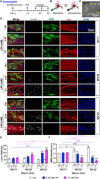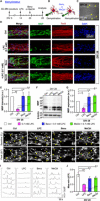A 3D disease and regeneration model of peripheral nervous system-on-a-chip
- PMID: 33514550
- PMCID: PMC7846159
- DOI: 10.1126/sciadv.abd9749
A 3D disease and regeneration model of peripheral nervous system-on-a-chip
Abstract
Demyelinating diseases involve loss of myelin sheaths and eventually lead to neurological problems. Unfortunately, the precise mechanisms remain unknown, and there are no effective therapies. To overcome these limitations, a reliable and physiologically relevant in vitro model is required. Here, we present a three-dimensional peripheral nervous system (PNS) microfluidic platform that recapitulates the full spectrum of myelination, demyelination, and remyelination using primary Schwann cells (SCs) and motor neurons (MNs). The platform enables reproducible hydrogel patterning and long-term stable coculture of MNs and SCs over 40 days in vitro based on three distinct design factors. Furthermore, the on-demand detachable substrate allows in-depth biological analysis. We demonstrated the possibility of mimicking segmental demyelination by lysophosphatidylcholine, and recovery of myelin structure by application of two drugs: benzatropine or methylcobalamin. This 3D PNS disease-on-a-chip may serve as a potential platform for understanding the pathophysiology of demyelination and screening drugs for remyelination.
Copyright © 2021 The Authors, some rights reserved; exclusive licensee American Association for the Advancement of Science. No claim to original U.S. Government Works. Distributed under a Creative Commons Attribution NonCommercial License 4.0 (CC BY-NC).
Figures





Similar articles
-
Methylcobalamin promotes the differentiation of Schwann cells and remyelination in lysophosphatidylcholine-induced demyelination of the rat sciatic nerve.Front Cell Neurosci. 2015 Aug 4;9:298. doi: 10.3389/fncel.2015.00298. eCollection 2015. Front Cell Neurosci. 2015. PMID: 26300733 Free PMC article.
-
Optogenetic neuronal stimulation promotes axon outgrowth and myelination of motor neurons in a three-dimensional motor neuron-Schwann cell coculture model on a microfluidic biochip.Biotechnol Bioeng. 2019 Oct;116(10):2425-2438. doi: 10.1002/bit.27083. Epub 2019 Jul 4. Biotechnol Bioeng. 2019. PMID: 31180148
-
Coculture of Primary Motor Neurons and Schwann Cells as a Model for In Vitro Myelination.Sci Rep. 2015 Oct 12;5:15122. doi: 10.1038/srep15122. Sci Rep. 2015. PMID: 26456300 Free PMC article.
-
The role of oligodendrocytes and oligodendrocyte progenitors in CNS remyelination.Adv Exp Med Biol. 1999;468:183-97. doi: 10.1007/978-1-4615-4685-6_15. Adv Exp Med Biol. 1999. PMID: 10635029 Review.
-
[Protein composition and structure of the myelin sheath. Part I].Pol Merkur Lekarski. 2003 Sep;15(87):268-72. Pol Merkur Lekarski. 2003. PMID: 14679855 Review. Polish.
Cited by
-
The Evolution of Technology-Driven In Vitro Models for Neurodegenerative Diseases.Adv Sci (Weinh). 2024 Apr;11(16):e2304989. doi: 10.1002/advs.202304989. Epub 2024 Feb 17. Adv Sci (Weinh). 2024. PMID: 38366798 Free PMC article. Review.
-
Neuromuscular Development and Disease: Learning From in vitro and in vivo Models.Front Cell Dev Biol. 2021 Oct 27;9:764732. doi: 10.3389/fcell.2021.764732. eCollection 2021. Front Cell Dev Biol. 2021. PMID: 34778273 Free PMC article. Review.
-
Multidimensional advances in neural interface technology for peripheral nerve repair: From material innovation to clinical translation.Mater Today Bio. 2025 Jul 14;34:102092. doi: 10.1016/j.mtbio.2025.102092. eCollection 2025 Oct. Mater Today Bio. 2025. PMID: 40727303 Free PMC article. Review.
-
Brain physiome: A concept bridging in vitro 3D brain models and in silico models for predicting drug toxicity in the brain.Bioact Mater. 2021 Nov 12;13:135-148. doi: 10.1016/j.bioactmat.2021.11.009. eCollection 2022 Jul. Bioact Mater. 2021. PMID: 35224297 Free PMC article. Review.
-
Schwann cells are axo-protective after injury irrespective of myelination status in mouse Schwann cell-neuron cocultures.J Cell Sci. 2023 Sep 15;136(18):jcs261557. doi: 10.1242/jcs.261557. Epub 2023 Sep 20. J Cell Sci. 2023. PMID: 37642648 Free PMC article.
References
-
- Mirsky R., Jessen K. R., Schwann cell development, differentiation and myelination. Curr. Opin. Neurobiol. 6, 89–96 (1996). - PubMed
-
- Martin R., Mcfarland H. F., Mcfarlin D. E., Immunological aspects of demyelinating diseases. Annu. Rev. Immunol. 10, 153–187 (1992). - PubMed
-
- Pardo I. D., Rao D. B., Butt M. T., Jortner B. S., Valentine W. M., Arezzo J., Sharma A. K., Bolon B., Toxicologic pathology of the peripheral nervous system (PNS): Overview, challenges, and current practices. Toxicol. Pathol. 46, 1028–1036 (2018). - PubMed
Publication types
LinkOut - more resources
Full Text Sources
Other Literature Sources

